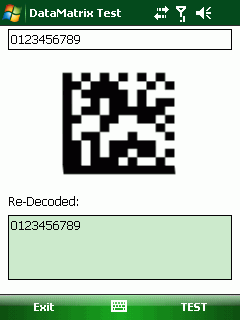If you need to print, show, generate or analyse DataMatrix Barcodes on a Windows Mobile device, you can now use this class library. I have ported the code to be compatible with Compact Framework 2.0 and Visual Studio 2005.
The original full .NET Framework source code is located at SourceForge.
Here is first a screenshot of the test application running on a Windows Mobile device using the DataMatrixNetCF class:

The full .NET framework has many more functions or the classes provide more optional arguments than Compact Framework (CF) does. So there is some code to be changed to work with CF. BTW: you can run the code on a desktop PC to, as the Full Framework is upwards compatible to CF.
I had to change some constructs which are used to initialize a structure directly with some values. Here is one example for DmtxDecode.cs:
Original:
DmtxPixelLoc pEmpty = new DmtxPixelLoc() { X = 0, Y = 0 };
Visual Studio 2005 / Compact Framework 2:
DmtxPixelLoc pEmpty = new DmtxPixelLoc();
pEmpty.X = 0; pEmpty.Y = 0;
Similar changes have to be applied to a lot of code lines:
Original:
follow.Loc = new DmtxPixelLoc() { X = followBeg.Loc.X +
DmtxConstants.DmtxPatternX[patternIdx], Y = followBeg.Loc.Y +
DmtxConstants.DmtxPatternY[patternIdx] };
Visual Studio 2005 / Compact Framework 2:
follow.Loc = new DmtxPixelLoc(followBeg.Loc.X +
DmtxConstants.DmtxPatternX[patternIdx], followBeg.Loc.Y +
DmtxConstants.DmtxPatternY[patternIdx]);
To get this working, the structure defined in DmtxPixelLoc.cs had to get a constructor code:
public DmtxPixelLoc(int x, int y)
{
_x = x;
_y = y;
}
As the compiler complained about this ugly construct, I rewrote this:
prevPrevValue = (byte)((prevIndex > channel.FirstCodeWord / 12) ?
channel.EncodedWords[prevIndex - 1] : 0);
to this:
if (prevIndex > channel.FirstCodeWord / 12)
prevPrevValue = channel.EncodedWords[prevIndex - 1];
else
prevPrevValue = 0;
I don't like this short form of If/else.
Finally, it took some time to convert this code of the file DmtxImageEncoder.cs to CF:
internal static Bitmap CopyDataToBitmap(byte[] data, int width, int height)
{
data = InsertPaddingBytes(data, width, height, 24);
int stride = 4 * ((width * 24 + 31) / 32);
GCHandle dataHandle = GCHandle.Alloc(data, GCHandleType.Pinned);
Bitmap bmp = new Bitmap(width, height, stride,
PixelFormat.Format24bppRgb, dataHandle.AddrOfPinnedObject());
return bmp;
}
In compact framework, this works:
internal static Bitmap CopyDataToBitmap(byte[] data, int width, int height)
{
data = InsertPaddingBytes(data, width, height, 24);
int stride = 4 * ((width * 24 + 31) / 32);
GCHandle dataHandle = GCHandle.Alloc(data, GCHandleType.Pinned);
Bitmap msBMP = new Bitmap(width,height,PixelFormat.Format24bppRgb);
Rectangle rect = new Rectangle(0, 0, msBMP.Width, msBMP.Height);
System.Drawing.Imaging.BitmapData bmpData =
msBMP.LockBits(rect, System.Drawing.Imaging.ImageLockMode.ReadWrite,
PixelFormat.Format24bppRgb);
IntPtr ptr = bmpData.Scan0;
int bytes = bmpData.Stride * msBMP.Height;
System.Runtime.InteropServices.Marshal.Copy(data, 0, ptr, bytes);
msBMP.UnlockBits(bmpData);
return msBMP;
}
Here, you can download the source code of the class library and a test application. The code is written in Visual Studio 2005 with Windows Mobile 5 SDK as target.
If you need some PDF library for Windows Mobile, see my port of iTextSharp. The sourceforge DataMatrixNet code uses iTextSharp too.






